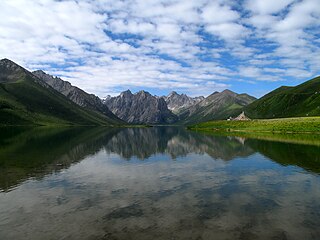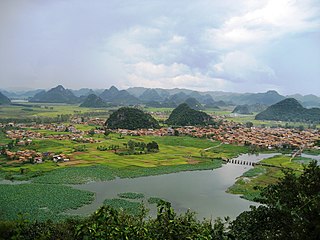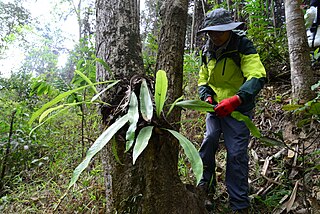
Xishuangbanna, sometimes shortened to Banna, is an autonomous prefecture for Dai people in the extreme south of Yunnan Province, China, bordering both Myanmar and Laos. The prefectural seat is Jinghong, the largest settlement in the area and one that straddles the Mekong, called the "Lancang River" in Chinese.

Yuanyang County is located in Honghe Prefecture in southeastern Yunnan province, China, along the Red River. It is well known for its spectacular rice-paddy terracing. In 2013, part of the county formed the Honghe Hani Rice Terraces World Heritage Site, the 45th World Heritage Site in China.

Ruili is a county-level city of Dehong Prefecture, in the west of Yunnan province, China. It is a major border crossing between China and Myanmar, with the town of Muse located across the border.

Pu'er is a prefecture-level city in southern Yunnan Province, China. The urban administrative center of Pu'er is Simao District, which is also the former name of the prefecture-level city itself. A major downturn in the price of tea in 2007 caused severe economic distress in the area. The price of Pu'er has since recovered and Pu'er tea, a type of dark tea, still contributes much to the income of the area.

The Wuyi Mountains or Wuyishan are a mountain range located in the prefecture of Nanping, in northern Fujian province near the border with Jiangxi province, China. The highest peak in the area is Mount Huanggang at 2,158 metres (7,080 ft) on the border of Fujian and Jiangxi, making it the highest point of both provinces; the lowest altitudes are around 200 metres (660 ft). Many oolong and black teas are produced in the Wuyi Mountains, including Da Hong Pao and lapsang souchong, and are sold as Wuyi tea. The mountain range is known worldwide for its status as a refugium for several rare and endemic plant species, its dramatic river valleys, and the abundance of important temples and archeological sites in the region, and is a UNESCO World Heritage Site.

The Dehong Dai and Jingpo Autonomous Prefecture is an autonomous prefecture in western Yunnan province, China. It is bordered by Baoshan to the east and Myanmar's Kachin State to the west. Its titular ethnic minorities are the Dai and Jingpo, who make up 28 and 11 percent of the prefecture's population, respectively.

Mangshi, former name Luxi (潞西), is a county-level city and the seat of Dehong Dai and Jingpo Autonomous Prefecture, western Yunnan province, China. Mangshi has an area of 2,900.91 km2 (1,120.05 sq mi), with an urban area of 18.66 km2 (7.20 sq mi). Han Chinese, Dai people and Jingpo people are the major ethnic groups. Luxi County was founded in 1949, and became a county-level city in 1996.
The Ailao toad is a species of toad in the family Bufonidae. It is endemic to China. Its natural habitats are subtropical or tropical moist montane forests and rivers. It was discovered in the Ailaoshan National Nature Reserve in Ailao Mountains, Yunnan. The toad was first described in 1984 and has not been seen since, as it is hard to find and thought to be rare. It is a small toad, about 40 mm (1.6 in) in length.
Amolops tuberodepressus is a species of frog in the family Ranidae. It is endemic to Yunnan, China and known from Wuliang and Ailao Mountains in Jingdong County. Once suspected to be synonym of Amolops mantzorum, its validity was confirmed with molecular methods in 2014.

The Yunnan–Guizhou Plateau or Yungui Plateau is a highland region located in southwest China. The region is primarily spread over the provinces of Yunnan and Guizhou. In the southwest, the Yungui is a true plateau with relatively flatter highland areas, while in the northeast, the Yungui is a generally mountainous area of rolling hills, gorges, and karst topography.
Yingjiang County is a county in Dehong Prefecture, Yunnan province, China, bordering Burma's Kachin State to the west.

A plant community is a collection or association of plant species within a designated geographical unit, which forms a relatively uniform patch, distinguishable from neighboring patches of different vegetation types. The components of each plant community are influenced by soil type, topography, climate and human disturbance. In many cases there are several soil types present within a given plant community. This is because the soil type within an area is influenced by two factors, the rate at which water infiltrates or exits the soil, as well as the rate at which organic matter enters or decays from the soil. Plant communities are studied substantially by ecologists, due to providing information on the effects of dispersal, tolerance to environmental conditions, and response to disturbance of a variety of plant species, information valuable to the comprehension of various plant community dynamics.

The Xiaoxiang Range is a mountain range in Sichuan Province, China. It is part of a complicated system of mountains in south-central Sichuan, and runs in the general north-south direction within Liangshan Yi Autonomous Prefecture and the adjacent parts of Ya'an prefecture-level city.

The flora of China consists of a diverse range of plant species including over 39,000 vascular plants, 27,000 species of fungi and 3000 species of bryophytes. More than 30,000 plant species are native to China, representing nearly one-eighth of the world's total plant species, including thousands found nowhere else on Earth. China's land, extending over 9.6 million km, contains a variety of ecosystems and climates for plants to grow in. Some of the main climates include shores, tropical and subtropical forests, deserts, elevated plateaus and mountains. The events of the continental drift and early Paleozoic Caledonian movement also play a part in creating climatic and geographical diversity resulting in high levels of endemic vascular flora. These landscapes provide different ecosystems and climates for plants to grow in, creating a wide variety of different flora spanning over not just China, but different parts of the world.
Gutianshan National Nature Reserve is a nature reserve in Kaihua County, in the western part of Zhejiang Province, on the border of Jiangxi province. The reserve was established as a smaller, provincial-level nature reserve in 1975, and upgraded to its present size and status in 2001. The reserve occupies a mountainous, forested area, and is part of the Nanling mountains. The highest peak is Shiershan at 1,258 metres (4,127 ft).

The Yunnan Plateau subtropical evergreen forests is an endangered ecoregion in southwestern China. These forests once covered the western parts of the Yungui Plateau but have been significantly reduced and replaced with agricultural land uses. The Yunnan evergreen forests and the neighbouring Guizhou Plateau broadleaf and mixed forests are the only two ecoregions in the Palearctic realm to be classified as part of tropical and subtropical moist broadleaf forests biome.
Prunus perulata is a species of bird cherry native to Sichuan and Yunnan in China, preferring to grow at 2400–3200 m. It is a tree typically 6–12 m tall. Its flowers are borne on a raceme, quite small, with dull white to creamy-yellow petals. Its closest relative is Prunus buergeriana, from which it is morphologically and genetically distinct.

Founded in 2002, Ruili Botanical Garden and Nanmaohu Park is a botanical garden in Ruili. Located 6 km from the city in Dehong Dai and Jingpo Autonomous Prefecture of Yunnan in the South-West of China near the Myanmar border. The park has more than 5,000 acres of well-preserved native vegetation, mainly monsoon evergreen broad-leaved forest, with more than 1,200 species of tropical and subtropical plants.
Events from the year 1667 in China.
Hoya gaoligongensis grows in moist evergreen broad-leaved forests between 2000 and 2400 meters above sea level and is currently found only in pristine forests. It has the characteristics of living and growing on a large tree. It is very demanding on habitats such as forest quality, humidity, temperature and humus accumulation on bark surfaces. It was first found in Longling Xiaoheishan Provincial Nature Reserve, Yunnan Province, China.











